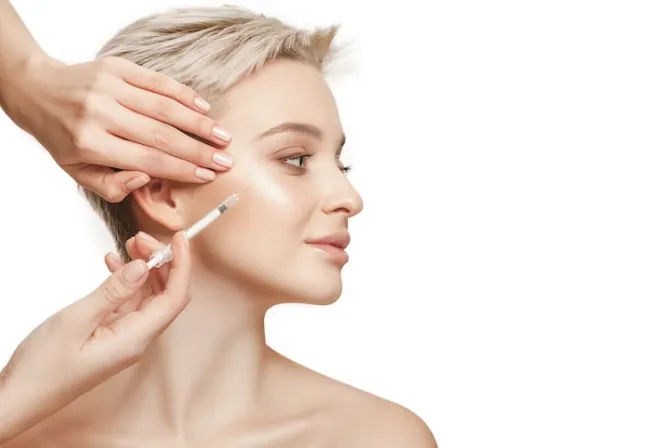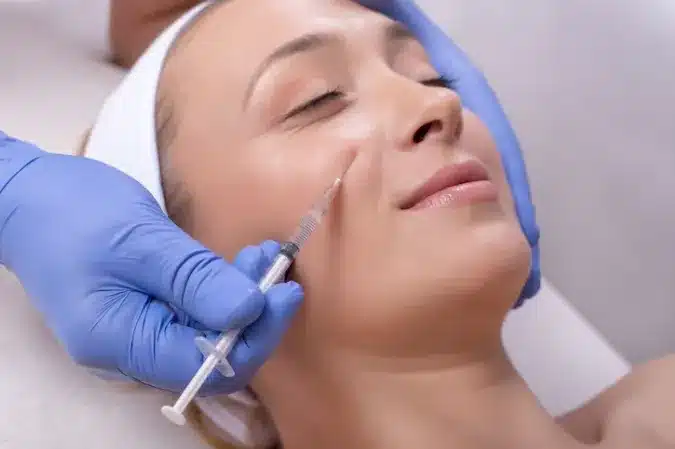Cheek augmentation through fat transfer and hyaluronic acid fillers offers a revolutionary approach to enhancing facial aesthetics. By utilizing liposuction to harvest fat for grafting, this technique provides a natural alternative for those seeking to add volume to their cheeks. Meanwhile, hyaluronic acid fillers present a quick, minimally invasive option, making both methods popular choices for achieving a more youthful and balanced facial appearance.
Both procedures aim to add volume to the cheeks, resulting in a fuller and more defined facial contour. However, there are essential differences between these two methods. This article will explore the distinctions between fat transfer and fillers for cheeks and discuss their benefits and risks.
Definition of Fat Transfers
Fat transfer, also known as fat grafting or fat injection, is a procedure that involves removing excess fat from one area of the body, typically through liposuction, and transferring it to another area, such as the cheeks.
The extracted fat is processed and purified before injected into the desired area, providing natural and long-lasting results. This technique adds volume to the cheeks and improves skin texture and elasticity.
Clinic contact number: +989371200167
Definition of Cosmetic Fillers
On the other hand, cosmetic fillers are injectable substances designed to add volume to specific areas of the face, including the cheeks. These filters are typically composed of hyaluronic acid, a naturally occurring substance in the body that promotes hydration and helps maintain the skin’s structure.
Individuals can achieve plumper and more youthful appearance without surgery by injecting fillers into the cheeks.

Difference between Fat Transfer and Fillers for Cheeks
While both fat transfer and fillers for cheeks aim to enhance facial volume, there are several critical distinctions between these procedures. One of the main differences lies in the source of the injected material.
Facial fat transfer surgery, also known as fat grafting or fat injection, is a cosmetic procedure that aims to restore volume, enhance facial contours, and rejuvenate the overall appearance of the face. Fat transfer utilizes the patient’s fat, making it a natural and biocompatible option. In contrast, fillers consist of synthetic substances, such as hyaluronic acid, which are commercially produced.
Additionally, fat transfer provides a more permanent solution compared to fillers. Once the fat cells have successfully integrated into the cheek area, they will likely remain there long term. Fillers, however, are temporary and require regular touch-ups to maintain the desired results.
Clinic contact number: +989371200167
Age Considerations for Fat Transfer and Fillers for Cheeks
The suitability of fat transfer and fillers for cheeks depends on several factors, including age. In general, individuals in their30s and beyond are more likely to benefit from these procedures as the natural aging process causes a loss of volume in the cheeks.
However, consulting with a qualified cosmetic surgeon to determine the most appropriate treatment plan based on individual circumstances is essential.

What are dermal fillers?
Dermal fillers contain hyaluronic acid and are used to treat early signs of ageing. Hyaluronic acid occurs naturally within the body, and the risk of allergic reactions is, therefore, minimal. For people who may not be keen on the idea of surgery, fillers are a great alternative for achieving anti-ageing effects without any downtime. Compared with fat transfer, dermal fillers are not a permanent treatment, although results can last over 12 months, depending on the treatment performed. Dermal filler treatment is an excellent non-surgical alternative to improve early signs of facial ageing. Dermal fillers can be used for many areas of the face, including:
- Cheeks
- Lips
- Nasolabial folds or nose-to-mouth lines
- Under eye or tear trough
- Jawline
- Chin
- Temples
There are a wide variety of different brands of dermal filler. Here at Centre for Surgery, Our specialists are experts in the use of Juvederm, Belotero and Restylane.

Benefits of Fat Transfer and Fillers for Cheeks
1. Improved Facial Contour: Both fat transfer and fillers can enhance the appearance of the cheeks, providing a more youthful and defined facial contour.
2. Natural-Looking Results: Fat transfer utilizes the patient’s fat, leading to natural-looking and long-lasting outcomes.
3. Skin Rejuvenation: Fat transfer can improve skin texture and elasticity, resulting in a more youthful complexion.
4. Minimal Downtime: Both fat transfer and fillers are minimally invasive procedures, allowing individuals to resume their daily activities shortly after treatment.
5. Customization: The amount of fat or filler injected can be tailored to meet the specific needs and desires of the patient.
6. Reduced Allergic Reactions: Since fat transfer uses the patient’s cells, the risk of allergic reactions is significantly reduced.
7. Long-Term Results: Fat transfer provides long-lasting results, eliminating the need for frequent touch-ups.
8. Versatility: Fillers can address aesthetic concerns beyond cheek augmentation, such as reducing fine lines and wrinkles.
9. Non-Surgical Option: Both fat transfer and fillers offer a non-surgical alternative to traditional cosmetic procedures.
10. Boosted Self-Confidence: A more youthful and rejuvenated appearance through fat transfer or fillers can significantly improve self-confidence.
Facial rejuvenation with fat transfer is an excellent option for patients who would like to enhance the volume of specific areas in the face or restore volume that has been lost with aging. The University of Toronto Education

Risks of Fat Transfer and Fillers for Cheeks
Fat transfer and fillers are popular cosmetic procedures for enhancing the appearance of cheeks, each with its benefits and potential risks. Here’s a summary of both:
Fat Transfer (Fat Grafting)
Fat transfer to the cheeks involves removing fat from one part of the body (such as the abdomen or thighs) through liposuction, processing it, and then injecting it into the cheek area. This procedure can provide natural-looking results, and since it uses the patient’s own fat, there’s no risk of allergic reaction. However, it carries risks such as:
Infection
As with any surgical procedure, there’s a risk of infection at the site of fat removal or injection.
Anesthesia Risks
The use of anesthesia always carries its own risks, including allergic reactions or adverse effects.
Irregularities
There might be lumpiness or unevenness in the areas where fat was removed or injected. The body might also absorb the transferred fat unevenly, leading to asymmetry.
Overcorrection/Undercorrection
Achieving the desired volume can be challenging; there might be a need for additional procedures to correct or adjust the results.
Necrosis
Rarely, the transferred fat cells might not establish a blood supply in their new location, leading to cell death and potentially causing hard lumps.
Dermal Fillers
Dermal fillers for cheeks are gel-like substances (often hyaluronic acid-based) injected beneath the skin to add volume and smooth lines. The procedure is less invasive than fat grafting, with minimal downtime, but it’s not without risks:
Allergic Reactions
Some people might have allergic reactions to the filler material, although this is rare with hyaluronic acid fillers.
Bruising and Swelling
Common side effects include temporary bruising, swelling, and redness at the injection sites.
Lumps and Asymmetry
Improperly injected fillers can lead to lumpiness or asymmetry. While hyaluronic acid fillers can often be dissolved with an enzyme (hyaluronidase), this is not the case for all filler types.
Infection
Though rare, there’s a risk of infection at the injection sites.
Vascular Occlusion
A very serious, though rare, complication occurs when the filler accidentally gets injected into a blood vessel, potentially leading to skin necrosis or even blindness.
Both procedures should be performed by qualified and experienced professionals to minimize risks. It’s also essential for patients to discuss their medical history, allergies, and expectations with their doctor to ensure the best possible outcomes.
Clinic contact number: +989371200167
Innovations and Trends in Cheek Augmentation
Fat transfer and fillers for cheeks have become increasingly popular as individuals seek non-invasive ways to achieve youthful, fuller facial contours. Leading the research and application in this arena, Johns Hopkins University and its affiliated medical facilities have been at the forefront, contributing significantly to advancements and safety protocols in cosmetic procedures. Renowned specialists such as Dr. Sydney Coleman, who pioneered techniques in fat grafting, have made substantial contributions to the field, enhancing the predictability and outcomes of these procedures.
Moreover, the American Society of Plastic Surgeons reports a steady rise in the demand for these treatments, with fat grafting procedures experiencing a notable increase of 10% in the last year alone, highlighting the growing trust and preference for natural augmentation methods among patients. On the commercial side, Allergan, the maker of popular hyaluronic acid-based fillers like Juvéderm, has emerged as the most active company in the realm of cheek augmentation through fillers. Their continuous innovation and comprehensive range of filler products have positioned them as leaders in the aesthetic medicine industry, catering to a wide array of patient needs and preferences.
The Mayo Clinic, known for its meticulous approach to patient care and cutting-edge cosmetic procedures, stands out as the most active hospital in performing these treatments, offering both fat transfer and synthetic filler options to achieve desired cheek enhancement. With over a million filler procedures performed annually, according to the latest statistics from the American Society of Plastic Surgeons, the emphasis on safety, efficacy, and natural-looking results remains paramount, driving ongoing research and development in the field.

Summary
Cheek augmentation through fat transfer and dermal fillers has marked a significant advancement in the field of cosmetic surgery, offering individuals the opportunity to achieve natural-looking results with minimally invasive techniques. The process of liposuction followed by fat grafting allows for a dual benefit—reducing unwanted fat in one area while enhancing facial contours—making it a highly sought-after procedure for those looking for a more harmonious facial appearance. This autologous approach ensures compatibility and reduces the risk of adverse reactions, making it a safe and effective option for volume enhancement.
On the other hand, dermal fillers provide a quick and convenient alternative for cheek augmentation, with hyaluronic acid-based products leading the charge. These fillers not only offer immediate results but also have the flexibility of being reversible, allowing adjustments to be made to achieve the desired outcome. Whether opting for the natural path of fat grafting or the versatility of dermal fillers, patients now have access to cutting-edge solutions in cosmetic surgery that prioritize safety, efficacy, and achieving the most natural-looking results possible.
FAQs
1. What is the primary difference between fat transfer and fillers for enhancing cheeks?
The primary difference lies in the material used for augmentation. Fat transfer involves using your own body fat, harvested from another area, processed, and then injected into the cheeks. Dermal fillers, on the other hand, use synthetic or natural substances, such as hyaluronic acid, poly-L-lactic acid, or calcium hydroxylapatite, injected directly into the cheeks. Fat transfer is a more invasive process requiring liposuction, while fillers are a non-surgical, minimally invasive option.
2. Which provides a more natural look, fat transfer, or fillers?
Both procedures can offer natural-looking results when performed by skilled practitioners. Fat transfer uses your own body fat, which can integrate well with your facial tissues, potentially providing a very natural feel and appearance. Dermal fillers are designed to mimic the body’s own substances (like hyaluronic acid), and expert application can also yield very natural-looking enhancements. The choice between the two often depends on the patient’s preferences, the desired outcome, and the practitioner’s recommendation.
3. How long do the results last from fat transfer compared to fillers?
Fat transfer can provide long-lasting, sometimes permanent results. However, there is an initial absorption rate where some of the transferred fat is reabsorbed by the body, and the final volume stabilizes over several months. Dermal fillers have a temporary effect, lasting from 6 months to over 2 years, depending on the type of filler used. Fillers will eventually need to be re-injected to maintain the desired effect.
4. What is the recovery time for fat transfer versus fillers?
Recovery from fat transfer is generally longer and might involve more discomfort due to the liposuction procedure needed to harvest the fat. Patients may experience swelling and bruising at both the donor and recipient sites, with a typical downtime of a week or more. Dermal fillers have minimal recovery time, with most patients returning to their normal activities immediately or within a day, although there may be some swelling or bruising at the injection sites.
5. Are there any risks or side effects associated with fat transfer and fillers?
Both procedures come with potential risks and side effects. Fat transfer risks include infection, bleeding, and uneven texture or asymmetry due to the way the fat settles or is absorbed. There’s also a risk of fat necrosis (dead fat cells) which can affect the outcome. Fillers can cause reactions at the injection site, such as redness, swelling, and bruising, and in rare cases, can lead to more serious complications like infection or filler migration. Additionally, there’s a risk of vascular occlusion (blockage of blood vessels) with fillers, which can lead to tissue damage if not promptly addressed.
Choosing between fat transfer and fillers for cheek augmentation depends on individual goals, the desired longevity of results, tolerance for downtime, and personal health. Consulting with a board-certified plastic surgeon or dermatologist can provide tailored advice and help you make an informed decision based on your unique facial structure and cosmetic objectives.
Facial Rejuvenation (Fat Injections, Fat Grafting) | Resident and Fellow Aesthetic Surgery Clinic (uoftplasticsurgery.ca)
Facial Fat Transfer vs Fillers | Centre for Surgery



